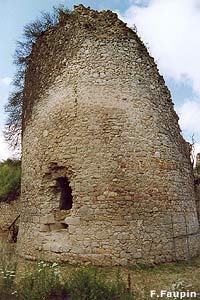|
History of the castle

- Description of
the site
1-1
the Holy mound Maguerite
On which the church
(1488 foundation of the church) is located having survived modern
times. This mound of oval form of 55 X 45 meters (bases) sheltered
the first castle out of wooden of IXe? XIIe century.
1-2
the mound with stem
Of low height (approximately
5m for a base d?environ 35 X 45m), it was to shelter a tower of
advanced defense (XIII century?).
1-3
the stone castle
It is towards the beginning
of XIIIe century that the mound Saint Maguerite is given up and
that 150m further is built the fortress out of stone. This castle
having the shape of an irregular polygon, was to comprise a low
court (of which the vestiges are visible in a farm). It consists
of a confined enclosure of 6 turns dating from XVe and XVIe centuries
(drain-holes and remainders of a chimney of 1500 in tower 1 for
example). Tower 2 still comprises a beautiful domical vault as well
as furnaces (remainders of kitchen?).
-
the
main tower : The keep of Lastours, high of approximately
20m, is of square plan (approximately 9m on side). It comprises
four stages equipped with chimneys and bays (with coussièges).
Does its base seem to be Emmottée (XIIe origin of the
building?) and comprises several rehandlings or rebuildings.
This type of keep says "ROMANCE" appears to be antiquated
because of its late date (medium of XIIIe century) and are connected
with the Romance keeps of the West of France in particular Eschizadour,
Chalucet or Castle-Chervix in High Vienna. The Southern and
Western faces are partly ruined. One reached it by a door the
level of the first stage (Northern face).
-
the
home of XIIIe - XIVe centuries: This home located behind
tower 6 and in prolongation of tower 1 is datable of XIIIe or
XIVe century (archères cruciform). It is preserved only
in its low part (first level) and comprises on its frontage
external of the flat buttresses of the type of those of the
main tower. Could it be a question of a second keep? This home
"was emmotté" by the enclosure of XVe century
with the creation of a braie (sheath of advanced defense).
- History
 Lastours
appears in the texts at the end of IXe century. Most known of its
lords is Goufier de Las Turns (about 1090). In XIIe century, GUI
of Mow Turns dies out of Holy Land and at the end of this same century
(v. 1173) Olivier de Las Turns drives out with the Viscount of Limoges
the lorry drivers to the pay of the English. The weapons of the
Mow Turns consist of three turns of money sown of flowers of lily
d'or. Lastours
appears in the texts at the end of IXe century. Most known of its
lords is Goufier de Las Turns (about 1090). In XIIe century, GUI
of Mow Turns dies out of Holy Land and at the end of this same century
(v. 1173) Olivier de Las Turns drives out with the Viscount of Limoges
the lorry drivers to the pay of the English. The weapons of the
Mow Turns consist of three turns of money sown of flowers of lily
d'or.
These three turns symbolize the three castrated Mow Turns which
are: Lastours (87), Pompadour (19) and Hautefort (24).
The three properties of the Mow Turns before XIVe century make it
possible to know the extent of their possessions. The Mow Turns
are useful in the armies of king de France and in 1452 Jean de Las
Turns is to advise of Charles VII. Jean de Las Turns rebuilds his
castle between 1477 and 1520. After many difficulties of succession,
the seigniory of Mow Turns with found about 1530 a certain importance.
The chalk-lining of the Mow Turns dies out definitively in 1591
with Jean III. His/her daughter and single heiress marry Gabriel
d' Abzac. The fortress undergoes an attack during the Sling. In
1783, the seigniory of Lastours is repurchased by the count of the
Bus (important field made up with the detriment of that of the Mow
Turns in XIVe century). In 1793, the revolutionists order the dismantling
of the castle which becomes a stone quarry until the middle of the
XXe centuries.
Franck Faupin |




 Lastours
appears in the texts at the end of IXe century. Most known of its
lords is Goufier de Las Turns (about 1090). In XIIe century, GUI
of Mow Turns dies out of Holy Land and at the end of this same century
(v. 1173) Olivier de Las Turns drives out with the Viscount of Limoges
the lorry drivers to the pay of the English. The weapons of the
Mow Turns consist of three turns of money sown of flowers of lily
d'or.
Lastours
appears in the texts at the end of IXe century. Most known of its
lords is Goufier de Las Turns (about 1090). In XIIe century, GUI
of Mow Turns dies out of Holy Land and at the end of this same century
(v. 1173) Olivier de Las Turns drives out with the Viscount of Limoges
the lorry drivers to the pay of the English. The weapons of the
Mow Turns consist of three turns of money sown of flowers of lily
d'or. 
